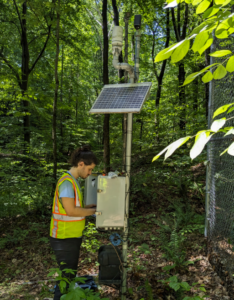
Wind turbines scattered among farms are a common sight in the northern half of Illinois. While wind development is an important component of our national energy portfolio, it is necessary to obtain informative data to help manage associated bat mortality
IBCP Sites in Illinois
One of the focal elements of the Illinois Bat Conservation Program is acoustic monitoring of bats across Illinois’ landscape in an effort to provide current data for resource conservation and management by the Illinois Department of Natural Resources. It certainly is not feasible to conduct acoustic sampling everywhere in Illinois, so we have chosen to implement the nationwide protocol NABat within Illinois, scaled to fit the available resources. The national team for NABat already generated a grid across the continent with individual grid cells, called GRTS, randomly ordered.

Using GIS, the GRTS grids are overlaid on the landscape, allowing us to plan driving routes
We’ve selected the first twenty GRTS in Illinois to be the primary focus of our acoustic monitoring (though we are also doing selective acoustic monitoring at other locations). Each of these GRTS, is a square comprising an area of 10X10 km (100 km2, or 24710.5 acres), and divided into four quarters. In each quarter, we attempt to place a stationary acoustic monitoring point, for a total of 2-4 stationary points in each GRTS, running for four nights.

Collecting acoustic data using a Pettersson M500 recorder on a pole with a laptop to log the data
Additionally, a driving route is established for each GRTS that traverses through each quarter of the GRTS. The driving route is completed on two different evenings within the four night period when the stationary recording stations are deployed. These data are collected annually during the warmer months, providing new data on bat activity in understudied areas of the state.
Methods of Acoustic Monitoring
Acoustic recorders are produced by a growing number of companies manufacture recorders, and we are utilizing recorders from: Wildlife Acoustics, Pettersson Elektronik and Titley Scientific — but this is by no means a complete list of manufacturers. The various models of recorders have differing strengths and weaknesses, and we aren’t recommending any model or brand.

Checking data at a long-term acoustic monitoring station.
Two types of acoustic data can be collected – zero crossing and full spectrum data. Zero crossing data is reduced to a series of points to signify the echolocation pulse and is valuable because it produces relatively small data files that are useful in bat identification. Full spectrum data is another kind of acoustic file that contains much more information, but has high demands on digital storage space. Full spectrum data can be helpful in interpreting problematic bat calls.
Acoustic monitoring is not a magic solution to bat monitoring — interpretation of calls requires significant training, and while there is some clearly objective information used for species identification, there is still some uncertainty and expert judgment necessary in identification of bat calls.

A stationary ultrasound recording station. The microphone is on top of the PVC pipe next to a tree trunk
While software can make preliminary identifications of calls based on geographic location (region) and other parameters (such as frequency range), definitive identification still requires expert examination of the calls – even then, some calls remain ambiguous. Nonetheless, bat acoustics fill an important role as a powerful resource management tool for measuring bat activity in the field.
